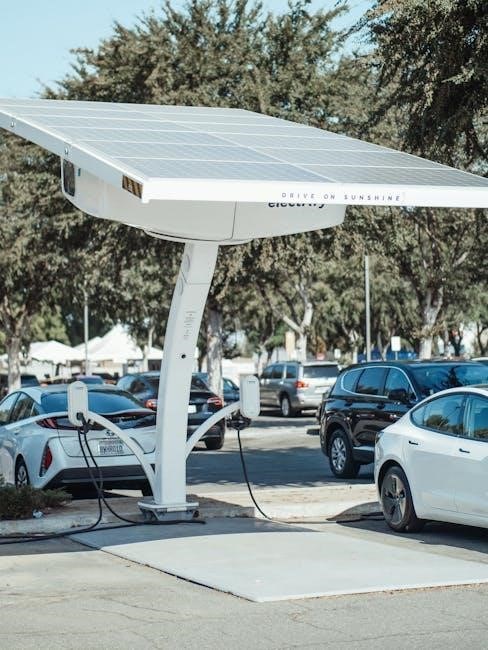Welcome to the DieHard Charger Instructions guide, designed to help you safely and effectively use your battery charger․ This manual provides essential safety tips, features, and troubleshooting advice to ensure optimal performance and longevity of your charger․ By following these instructions, you can maximize efficiency and maintain your battery health․
1․1 Overview of the DieHard Charger
The DieHard Charger is a fully automatic battery charger designed for home and light commercial use․ It offers features like 10/2 AMP settings, battery testing, and GFCI outlets for enhanced safety․ With models such as 200․71234 and 200․71221, it provides reliable charging for various battery types․ The charger includes a manual mode for precise control and is equipped with safety features to prevent overcharging and electrical hazards․ Its compact design and user-friendly interface make it ideal for both novice and experienced users, ensuring efficient and safe battery maintenance․
1․2 Importance of Following Instructions
Following the DieHard Charger instructions is crucial for safe and effective use․ Proper adherence ensures optimal battery charging, prevents damage to the charger or battery, and avoids potential electrical hazards․ The manual provides clear guidelines to help users navigate features, troubleshoot issues, and maintain the charger․ Ignoring instructions can lead to unsafe conditions or reduced performance․ By following the provided safety rules and operating procedures, users can maximize the charger’s efficiency and extend its lifespan while ensuring reliable battery maintenance and avoiding costly repairs․
Understanding the DieHard Charger
The DieHard Charger is a fully automatic, versatile charging solution designed for home and light commercial use․ It features advanced settings, safety protections, and troubleshooting guidance to ensure efficient battery maintenance and optimal performance․
2․1 Key Features of the DieHard Charger
The DieHard Charger is a fully automatic, 10/2 amp battery charger designed for home and light commercial use․ It features a built-in battery tester, GFCI-protected outlets, and advanced safety protections like overcharge prevention and thermal monitoring․ The charger supports multiple battery types and includes a user-friendly interface for easy operation․ Its robust design ensures durability, while the automatic charging mode simplifies the process․ Additional features include LED indicators for charging status and a compact design for convenient storage․ These features make it an ideal solution for maintaining and charging batteries efficiently and safely․
2․2 Components of the DieHard Charger
The DieHard Charger includes a digital display for monitoring charging status, high-current clamps for secure battery connections, and insulated cables for safety․ It features thermal sensors to prevent overheating and GFCI-protected outlets for added protection․ The charger also includes an on/off switch and LED indicators for power and charging status․ These components work together to ensure safe, efficient, and reliable battery charging․ Understanding each part is essential for proper operation and maintenance of the charger․
Safety Precautions
Always follow safety rules to prevent accidents․ Use GFCI-protected outlets, avoid overcharging, and keep the charger away from flammable materials․ Ensure proper ventilation and follow manual guidelines for safe operation․
3․1 General Safety Rules
Always read and follow the safety rules in the manual before using the DieHard Charger․ Ensure the charger is used in a well-ventilated area, away from flammable materials․ Avoid overcharging, as it can damage the battery or cause safety hazards․ Never touch electrical components with wet hands or while standing in water․ Keep the charger out of reach of children and pets․ If the charger overheats, disconnect it immediately․ Use only approved charging areas and follow all local safety regulations to ensure safe operation․

3․2 Pre-Use Checks and Precautions
Before using the DieHard Charger, inspect the charger and cables for any damage or wear․ Ensure the charging area is well-ventilated and free from flammable materials․ Verify that the charger is set to the correct voltage and ampere rating for your battery type․ Always connect the positive terminal first to avoid sparks․ Keep the charger away from direct sunlight and moisture․ Double-check that the battery is compatible with the charger’s settings․ Never leave the charger unattended during use and avoid overcharging, as it can damage the battery or pose a safety risk․

Installation and Setup
Install the DieHard Charger in a well-ventilated, dry area away from flammable materials․ Ensure the charger is placed on a stable, level surface and properly connected to a grounded power source for safe operation․
4․1 Choosing the Right Location for the Charger
When selecting a location for your DieHard Charger, ensure it is well-ventilated to prevent hydrogen gas buildup․ Avoid areas near open flames or sparks․ Keep the charger away from flammable materials and moisture․ Place it on a stable, level surface to prevent tipping․ Ideally, locate it close to the battery to minimize cable length․ Ensure the area is cool and dry, avoiding direct sunlight or extreme temperatures․ Proper grounding is essential, so choose a location with a grounded power outlet․ This setup ensures safety and optimal charging performance․
4․2 Connecting the Charger to a Power Source
Before connecting your DieHard Charger to a power source, ensure the outlet is grounded and can handle the charger’s power requirements․ Avoid using extension cords or overloaded circuits․ Plug the charger directly into a nearby outlet to prevent power loss․ Check the power cord for damage and ensure it is securely connected to both the charger and the outlet․ Verify that the charger is set to the correct voltage and mode for your battery type․ Always follow the manufacturer’s guidelines to ensure safe and efficient charging․
Charging Procedures
Always prepare the battery and set the charger to the correct voltage and mode․ Monitor the charging process closely to avoid overcharging․ Ensure safety and efficiency․
5․1 Preparing the Battery for Charging
Before charging, ensure the battery is cool and well-ventilated․ Turn off the charger and disconnect the battery from the vehicle․ Inspect terminals for corrosion and clean if necessary․ Check the battery voltage using the charger’s meter to confirm it matches the charger’s settings․ Wear protective gear, including gloves and safety glasses․ Refer to the manual for specific voltage requirements and charging modes․ Ensure all connections are secure to avoid sparks or electrical issues․ Proper preparation ensures safe and efficient charging․
5․2 Setting Up the Charger for Use
Begin by selecting the correct charging mode (e․g․, 12V) and adjusting settings like current (e․g․, 2A or 10A) based on the battery type and condition․ Ensure the charger is placed on a stable, heat-resistant surface․ Connect the positive (red) and negative (black) cables to the battery terminals, avoiding reverse polarity․ Plug in the charger and verify the display shows the correct voltage and current․ Use the charger’s built-in features, such as automatic mode, for safe and efficient charging․ Always refer to the manual for specific setup instructions․
5․3 Monitoring the Charging Process
Regularly monitor the charging process to ensure safety and efficiency․ Check the charger’s display for voltage, current, and charging status․ Ensure the battery voltage stabilizes and reaches the recommended level․ Avoid overcharging by setting a timer or using the charger’s automatic shut-off feature․ Keep the area well-ventilated and away from flammable materials․ If the charger or battery overheats, disconnect immediately․ Use the charger’s built-in diagnostic features to identify any issues․ Always follow the manual’s guidelines for monitoring and adjusting settings during charging․

Troubleshooting Common Issues
Identify common problems like no voltage or overheating․ Check connections, ensure proper settings, and use diagnostic features․ Reset the charger if issues persist, following manual guidelines․
6․1 Identifying Common Problems
Common issues with DieHard chargers include no voltage output, overheating, or faulty connections․ Check for loose wires, damaged cables, or incorrect settings․ If the charger doesn’t turn on, ensure it’s properly plugged in and the outlet is functional․ Overheating may occur due to high ambient temperatures or prolonged use; Verify battery connections are secure and clean․ If issues persist, consult the manual for diagnostic steps or reset procedures․ Always ensure the charger is used as specified to avoid malfunctions and maintain safety․
6․2 Diagnostic Techniques
Diagnosing issues with your DieHard charger involves checking power sources, cables, and connections․ Ensure the charger is properly plugged in and the outlet is functioning․ Use a multimeter to measure voltage output if the charger isn’t charging the battery․ Check for loose or corroded connections, as these can disrupt charging․ If error codes appear, refer to the manual for specific meanings․ Verify that the charger is set to the correct voltage and amp settings for your battery type․ Regular inspections can help identify and resolve issues promptly․
6․3 Resetting the Charger
To reset your DieHard charger, start by disconnecting it from both the power source and the battery․ Wait for 30 seconds to allow any residual power to discharge․ Reconnect the charger to the power source first, then to the battery․ If the charger has an error code, this process may clear it․ If issues persist, refer to the manual for specific reset procedures or perform a hard reset by pressing and holding the reset button if available․ Always ensure the charger is unplugged before attempting any reset to avoid electrical hazards․
Maintenance and Upkeep

Regular cleaning and inspection of the charger are essential for maintaining efficiency․ Store the charger in a dry, cool place to prevent damage and ensure longevity․
7․1 Cleaning and Inspecting the Charger
Regularly clean the charger using a soft, dry cloth to remove dirt and dust․ Inspect for signs of wear, such as frayed cords or damaged connectors․ Avoid harsh chemicals, as they may harm the unit․ Check for loose connections and tighten them if necessary․ Ensure all vents are clear to maintain proper airflow․ Store the charger in a dry, cool place when not in use to prevent corrosion․ Inspections should be done before and after each use to ensure safe and efficient operation․
7․2 Storing the Charger Properly
Store the DieHard charger in a cool, dry place away from direct sunlight and moisture․ Avoid extreme temperatures, as they can damage the unit․ Keep the charger out of reach of children and pets․ Ensure the charger is disconnected from power and the battery before storage․ Check for any damage or wear before storing․ Use the original packaging if available to protect the charger․ Proper storage helps maintain the charger’s performance and extends its lifespan․ Always follow the manufacturer’s guidelines for storage to ensure safety and efficiency․

Advanced Features and Settings
The DieHard charger offers advanced features like fully automatic mode and adjustable charging parameters for precise control․ These settings ensure optimal charging for various battery types and needs․
8․1 Using the Fully Automatic Mode
The DieHard charger’s fully automatic mode simplifies the charging process by automatically detecting battery voltage and selecting the appropriate charging mode․ This feature ensures safe and efficient charging without manual intervention․ To use it, simply connect the battery, select the automatic mode, and let the charger handle the rest․ The charger will monitor the battery’s state and adjust settings to prevent overcharging․ This mode is ideal for users of all experience levels, providing a hassle-free charging experience while maintaining battery health and safety․
8․2 Adjusting Charging Parameters

Adjusting charging parameters on your DieHard charger allows for customized charging experiences․ Users can select between 6V and 12V settings to match their battery type․ The charger also offers adjustable current settings, such as 2A or 10A, to suit different charging needs․ For precise control, manual mode enables you to set specific voltage and current levels․ This feature is particularly useful for deeply discharged batteries or specialty applications․ Always refer to the manual for guidance on adjusting settings to ensure safe and effective charging tailored to your battery’s requirements․

Optimal Charging Techniques
For optimal charging, select the correct voltage and current settings based on your battery type․ Avoid overcharging by monitoring the process and using automatic modes when available․
9․1 Best Practices for Battery Charging
Always follow best practices to ensure safe and efficient battery charging․ Use the DieHard charger’s automatic mode for hassle-free charging․ Monitor the process to avoid overcharging, which can damage the battery․ Set the correct voltage and current settings based on your battery type․ Regularly check connections for tightness and cleanliness․ Keep the area well-ventilated to prevent hydrogen buildup․ Avoid charging a completely dead battery without prior checking․ Refer to the manual for specific guidelines tailored to your battery and charger model; Proper techniques ensure longevity and performance of both the battery and charger․
9․2 Avoiding Common Charging Mistakes
To ensure safe and effective charging, avoid common mistakes; Never overcharge the battery, as it can cause damage or reduce lifespan․ Always use the correct voltage and current settings for your battery type․ Avoid charging in poorly ventilated areas, as hydrogen gas buildup can be dangerous․ Do not charge a completely dead battery without prior testing․ Ensure all connections are secure and free from corrosion․ Never bypass safety features or use incorrect cables․ Following these guidelines helps prevent accidents and maintains optimal charger performance․ Proper care ensures reliability and extends the life of your battery and charger․
By following the DieHard Charger Instructions, you ensure safe, efficient, and effective battery charging․ Always prioritize safety, use proper techniques, and maintain your charger for optimal performance and longevity․

10․1 Summary of Key Points
The DieHard Charger Instructions emphasize safety, proper usage, and maintenance for optimal performance․ Always read the manual, follow safety rules, and use the charger correctly․ Ensure the battery is prepared before charging, monitor the process, and address issues promptly․ Regular maintenance, such as cleaning and storing the charger properly, extends its lifespan․ Troubleshooting common problems and resetting the charger when needed are crucial for uninterrupted use․ By adhering to these guidelines, you can maximize efficiency, ensure battery health, and prolong the charger’s functionality․

10․2 Final Tips for Effective Use
To ensure the best experience with your DieHard Charger, always follow safety guidelines and manufacturer instructions․ Regularly inspect cables and connections for damage, and store the charger in a cool, dry place․ Use the correct settings for your battery type and monitor charging progress to avoid overcharging․ Keep the charger clean and avoid extreme temperatures․ By adhering to these tips, you can extend the lifespan of both your charger and battery, ensuring reliable performance and safety․
